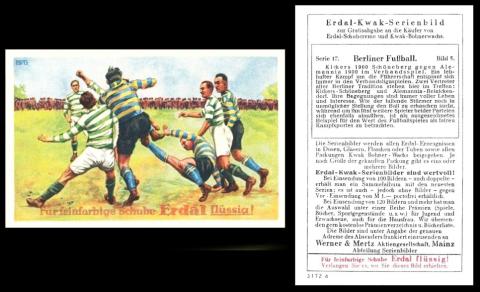
So we started with our regular Saturday Soccer Star, and this week we nipped over to Germany, for a spot of thrilling matchplay. But what we were after was the nickname of one of the teams, shown, Alemannia, which is "Kartoffel-Kafer" because they play in striped yellow and black jerseys. And this is the colour of a pest to local farmers, the Kartoffel--Kafer, or potato beetle.
And as an extra link, June bugs are actually Kafers too, or, in English, chafers. They are also double trouble, because the adults feed on vegetation, finding leaves especially tasty, whilst they lay their eggs underground so that when the young hatch they will be able to sustain themselves on the young and tender roots that they will almost immediately encounter beneath the soil. Another plant of choice is grass, which is probably the most plentiful species in most gardens.
Now there has been a lot of research done since this card was first used, including the fact that at first we classified it under E for Erdal. However we now know that this was a brand, operated by Werner & Mertz, of Mainz. And they are not only still in business, as Werner & Mertz GmbH, but it still a family company.
It all started in 1867, with a factory operated by Friedrich Christoph and Georg Werner, two brothers, which is why the company was called Gebruder Werner. Their business was selling waxes. They added a partner, another Georg, but with the surname of Mertz, hence Werner und Mertz. Sadly Herr Mertz died, in 1887, after which it was agreed that his brother in law took his place.
Their first real household name was "Erdal", which was shoe polish, and that was first marketed under that name in 1901, the same year that their new third partner also died, but yet again they kept it in the Mertz family and the new incumbent was the son in law of the man who had just gone. The name came from the street the factory was on, Erthalstrasse.
These cards are usually branded as "Erdal-Kwak", because "Kwak" was another of their brands, polish for floors. There was also "Blendol" which was metal polish, and that too is sometimes mentioned on the backs of their cards.
The shoe polish was made of natural substances, because there had been some criticism of shoe polish and its contents, which stained the clothing directly above it and also the hands of the user - no wonder, as most of it was either made from by-products of the coal industry, like sulphur and carbon, or from food-derivatives, including the discards of molasses that could not be eaten. They thought they needed a gimmick for their product, so they designed the character of the Frog-King, or "Rott Frosch" (red frog) in 1903, which was a frog, on a square of carpet, with a crown perched on his head. This was usually printed in red. However, once someone tried their shoe polish and found how well it worked, the little frog was not really needed.
Mind you I am not too sure what he has to do with polish, anyway, he comes from the story, recanted in Grimm`s Fairy Tales, and he was a Prince, turned into a frog, who met a Princess one day, and the two go home together. She does not really like him, but her father says she must be kind, and do his bidding, even let him sleep in her bed. And one day she finds that there is no longer a frog beside her, but a handsome prince. There is no kissing in the original story, that was added later, perhaps by parents who thought them sharing a bed was too risque.
In 1908, a fire broke out in the factory, and destroyed it, as you can imagine, with all that wax. There was also a second fire, in 1917, at their new premises. After that they had a purpose built factory built with a range of safety measures pre-installed, rather than adapted later.
In 1944 the factory was bombed by Allied forces, and most of it was again destroyed. Some of the workers there were captured prisoners of war, but it does not look like any of them were injured in the raid.
It was only in 1946, after the Second World War, that the company really diversified, into a range of household cleaners. Most of these were developed in house, using natural products, and this has turned into a great selling point as some of us become ever more eco-friendly. They dropped the use of all solvents in the mid 1990s, and now use only recycled plastic for their bottles. And in 2019 the current owner of the company, Reinhard Schneider, won the German Environment Prize.
The slogan on the bottom of this card is "Fur Fein Farbige Schuhe Erdal Flussig!". The first four words mean "For Fine Coloured Shoes", then "Erdal". However "Flussig", which I thought meant "polish" turns out to mean"free flowing", so it must have been liquid shoe polish. It was advertised as lasting longer and looking more beautiful for longer.
The albums for these sets were more like books, and the text was worked around empty spaces with framelines in which the cards were to be stuck. In these times they were not stickers, nor pre glued, you had to find your own glue.
This set is of just six cards, which are :
- Platzweihe des FC Weissensee 1900
- Hertha BSC - Holstein Kiel 4:2
- Norden-Nordwest-Berlin schägt Stettiner Preußen
- Tennis Borussia - Union-Oberschönwalde 4:0
- Kickers 1900 Schöneberg - Alemannia 1900
- Viktoria 1889 - SC Charlottenburg 10:1
